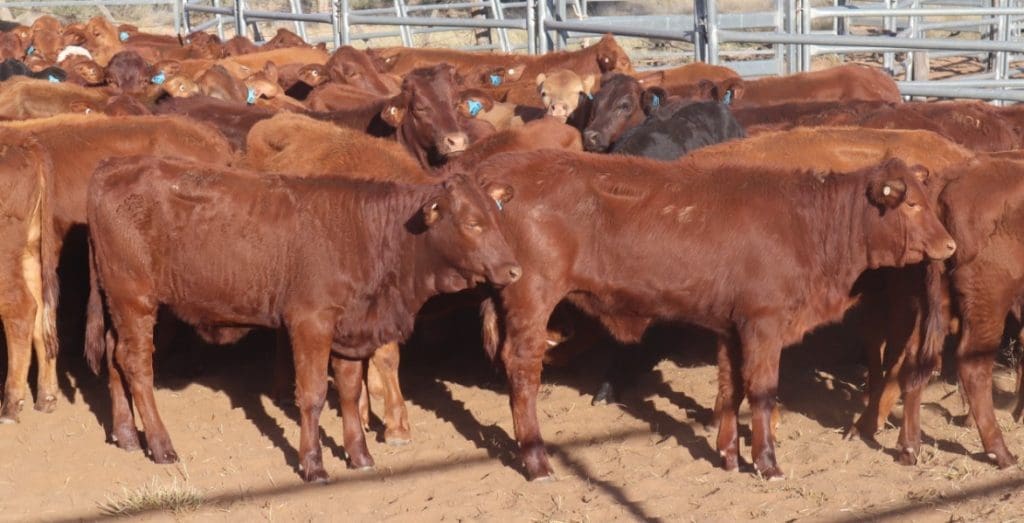
Among larger lines sold on AuctionsPlus recently, these 240 Santa cross heifers in store condition averaging 171kg from Adavale, far western Queensland made 307c/kg, while a further 106 heifer sisters averaging 280kg made 237c/kg. Both lines were described as offering ‘plenty of compensatory gain’ potential.
As dry conditions continue to encroach across large parts of Eastern Australia, there’s been a growing number of sale cattle listings for young store cattle where words like ‘potential for compensatory gain’ have appeared in the marketing preamble.
This large line of 346 Santa cross heifer weaners from Adavale in far western Queensland sold on last Friday week were a good example, but there have been plenty of others over the past three or four weeks.
Certainly feedlot operators were the big winners in young cattle exhibiting compensatory gain potential during the 2019-20 drought, but is it happening again? Are there opportunities for lotfeeders in young cattle suffering from growth checks due to deteriorating conditions?
Certainly skyrocketing cottonseed prices as reported on Beef Central earlier this week suggest there are a lot more young cattle now in need of nutritional support.

Matt George
Prominent feedlot consultant nutritionist Matt George from Bovine Dynamics thinks claims around compensatory gain are still a little premature, at this stage.
Among his feedlot clientele across eastern Australia, he said there were good young cattle out there now coming in in lighter condition off drier country, but he questioned whether there was yet any real sign of compensatory gain in backgrounders or feeders.
“We’re definitely not yet in drought conditions. Young cattle at intake might be leaner than what we’ve seen over the past couple of years, but its more like a normal winter cycle,” Dr George said.
“Yes, feedlot entry weights are dropping down through winter, but in my experience they are not ‘busted’ (subjected to significant nutritional checks earlier in life that produce compensatory gain) – just good, well grown young cattle in store or good store condition.”
Double-edged sword
Dr George described the phenomenon of true compensatory gain as a ‘double edged sword.’
“Yes, cattle will produce great average daily gain numbers. But in true compensatory gain, we see a lot more omental fat and high subcutaneous fat – but less marbling and seam fat in the carcase,” he said.
That additional liveweight gain from cattle exposed to compensatory gain did not all translate into true carcase merit. Some of the additional weight was in fact derived from body composition changes like thicker hides, and enlargement of the gastro-intestinal wall and liver.
Dr George said cattle displaying compensatory gain could often gain weight at 8-10pc better than everyday cattle of the same description.
“But most of that gain typically occurs in the first 40 days. When an animal sets itself back to ‘normal’ body fat, it tends to slow. PhD research years ago by Matt McCurdy on compensatory gain showed that the fat depots in those animals change, and when they get to normal fat depots, it re-sets.”
“People tend to feel good about extracting some compensatory gain from young cattle, and yes it’s true there is greater efficiency of carcase conversion, but it’s not all positive.”
Dr George said among his cohort of commercial feedlots, shortfed cattle were currently at numbers around 2kg/day average gain.
“We’re certainly not at 2.1kg or 2.15kg/day like we can be in drought years (compensatory gain effect), but cattle are still performing well,” he said.
Dry matter conversions were back to 5.4-5.45kg feed per kg bodyweight gain.
Good winter feeding performance
At the same time, feedlot cattle had delivered good feeding performance over the winter period this year, due to drier weather conditions. This was in stark contrast with winter last year, when persistent wet weather for months saw some disastrous growth rate results logged on some cattle.
“Part of it is also due to some good mixed crossbred cattle again, with a bit more British and Euro infusion in them. In earlier years, a lot of higher grade Brahman type animals ended up down well into New South Wales, during the herd rebuilding phase. Many of those cattle (and their progeny) have now gone through the system last year and earlier this year.
“It could be argued we’re probably now back into the better crossbred cattle again, after that cycle, with a bit more hybrid vigour,” Dr George said.
Marbling performance is also often seen as being compromised after significant nutritional setback earlier in life.
“When it happens, it’s often about a half marbling score less on average across compromised cattle,” he said.
“We clearly saw it in Angus x Wagyu cattle through the drought. While carcase weights were quite high, due to good growth, they were broken (nutritionally) early in their lives. What we did see was the movement of the fat depots, with the same level of rib fat – but they just did not have the marbling – around a half score less, on average, on those type of cattle.”
“But this year, winter weightgain has been good – as has marbling performance – suggesting there is not yet any real signs of compensatory gain. Many feeders this winter have had at least good (and in many cases much better than good) conditions right through their life cycle.”
“But they are not coming into the feedlot over-fat, because it’s drying off in many areas.”
“Carcase weights, if anything, relative to their entry weights, are actually heavier this year, which is delivering a marbling gain as well. Everything else being even, better rates of gain will transfer into improved marbling as well.”
While cattle suffering serious nutritional setbacks at the end of droughts could also present greater respiratory disease challenges, this year was different, Dr George said.
“We’ve had more health challenges in feedlots this winter than we would have expected, given the good nutrition history of the feeders. It’s not as if the sky is falling in, but respiratory has just been bubbling around more than normal, despite the great feeding conditions.”
“I don’t believe this relates back to the earlier drought damage period. I put it down simply to unusual weather fluctuations. We’ve had short periods of cold this winter, but it was 28 degrees on the Darling Downs in early August.”
Some yards were currently pulling a couple of hundred a week – not out of control, but just bubbling away, Dr George said.
“Some of it might have related to a little more British cross in some feeder intakes, and potentially, with recent cattle market adjustments, a little more ‘bottom feeding’ may have happened, with a few more saleyard odds and ends passing through yards.”
“All those things, individually, tend to add up in respiratory performance,” Dr George said.



HAVE YOUR SAY